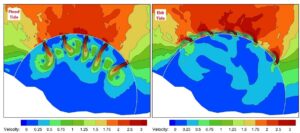Coastal areas face challenges, but also offer their own opportunities, as shown by the key ideas and themes of the first international conference of IWA’s new Specialist Group on Sustainable Coastal and Estuarine Development.
The venue of the inaugural conference of IWA’s new Specialist Group (SG) on Sustainable Coastal and Estuarine Development (SCED) was particularly fitting, being hosted by Hohai University at its new, world-class campus in Changzhou, China. Located in Jintan Changdang Lake Tourist Resort, in Jiangsu Province, the new campus specialises in water conservancy and provides a space with water management and sustainability at its heart.
Featuring esteemed keynote speakers from far and wide across the globe, including Australia, China, India, South Korea, the UK and the USA, this forward-looking event gave the opportunity for varied experiences to be elaborated on and potential opportunities to be discussed – most particularly with regards to improving water and energy security.
The conference was successful in attracting 14 keynote and 10 invited lecture presentations on a wide range of topics, including: coastal reservoirs for water supply; estuarine water quality challenges; tidal barrages and lagoons for energy supply; flood management; salinity intrusion in surface and groundwater; algal blooms; underground dams; eco-hydrology; and nature-based solutions from catchment to coast. The conference also included excellent presentations on a wide range of related topics from practitioners and researchers.
Opened by Professor Jinhai Zheng, Vice President of Hohai University, the organisers are particularly grateful to the university for its efforts in making the conference such a success. In addition, IWA’s SG SCED was delighted to have the support of IWA Past President Professor Glen Daigger, who delivered a thought-provoking keynote speech focusing on ‘Global Water Challenges and Water Profession Responses’, which was well received by delegates.
Challenges of sea level rise
The multiple causes of stress to coastal and estuarine ecosystems caused by climate change, population growth, industrial and urban development were discussed by Professor Muttucumaru Sivakumar in his opening address. He drew particular attention to contaminant fluxes and changes in the exchange of sea and fresh water that may occur, along with the challenges that sea level rise predictions pose.
The sustainability of future major developments along coasts and in estuaries, including large scale infrastructure projects such as coastal reservoirs, tidal lagoons, and urban regeneration infrastructure, will be governed by how well they are designed and managed, and the restoration or net gain of the health of the associated ecosystem and regional morphology.
He followed this up with a keynote speech on ‘Climate Resilient Water Supply and Flood Control’, focused on a proposed second-generation coastal reservoir in the Brisbane River Estuary, Australia. The numerical model results presented showed that, with suitable gate operation, flood levels in Brisbane city upstream of the reservoir could be reduced by up to 0.58 m (an improvement of 13%). With cooperation under the joint operation of a coastal reservoir and Wivenhoe dam, the levels can be reduced by 1.13 m (an improvement of 28%), which could significantly reduce damage to infrastructure currently at risk of flooding.
Improving energy security in the UK
Professor Roger Falconer’s keynote address on ‘Tidal Renewable Energy Development in a UK Estuarine Basin: Challenges and Opportunities’ reviewed the background to the necessity for improved renewable energy security in the UK, and outlined the benefits of indigenous, predictable and reliable energy from tidal resources.
He highlighted the considerable opportunities for tidal energy to be generated within the Severn Estuary and Bristol Channel – an estuarine basin with the second highest tidal range in the world.
 The hydrodynamic characteristics of the Severn Estuary make this a unique estuarine basin, with high tidal ranges and currents, high levels of turbidity, little sunlight penetration, reduced dissolved oxygen saturation levels, and limited – but unique – aquatic life and bird populations.
The hydrodynamic characteristics of the Severn Estuary make this a unique estuarine basin, with high tidal ranges and currents, high levels of turbidity, little sunlight penetration, reduced dissolved oxygen saturation levels, and limited – but unique – aquatic life and bird populations.
Numerical model results show that two-way generation can provide as much energy as ebb-only generation, with the benefit of sending four, rather than two, energy pulses to the grid per lunar day. The latest design of coastal reservoirs proposed for tidal energy generation also offer many other benefits to local communities.
Back to the future
In a passionate keynote speech, Professor Shuqing Yang addressed ‘Past-present-future Water Solutions and Their Comparisons’. Historically, diverse solutions – ranging from traditional wells and ponds to advanced desalination plants and wastewater recycling systems – have been employed to address water security.
He critically examined the motivations behind the adoption of these varying water solutions across historical timelines, as well as the multifaceted outcomes they engendered. Emerging prominently in this analysis has been the transformative potential of second-generation coastal reservoirs, such as the Qingcaosha Reservoir in the Yangtze Estuary, China. These reservoirs not only promise an abundant supply of fresh water for burgeoning coastal communities, but also herald a new era in which the water needs of inland and coastal regions can be met holistically.
Ningbo and Zhoushan study
‘The Feasibility Study of Coastal Reservoirs in Ningbo and Zhoushan, China’ was the subject of Professor Pengzhi Lin’s keynote speech, which presented historical hydrological data of the Ningbo and Zhoushan reservoirs, analysed the characteristics of the river basins and coastline, and detailed the options that could be explored. Because of the distribution of river basins and landforms, the northeast plain area of Ningbo is suitable for the construction of tidal flat reservoirs and estuary reservoirs, while Xiangshan Port and Sanmen Bay basin are suitable for the construction of estuary reservoirs, combined with a river reservoir, and a river mouth reservoir. The possibility for coastal reservoirs for the main island of Zhoushan, the large island of Qushan, and the small island of Dongfushan, were also proposed and discussed.
Making theory a reality
Overall, the event found that future research and development in sustainable coastal and estuarine opportunities should concentrate on the following pivotal areas.
Integrated development
Coastal reservoirs present a multitude of opportunities. The open water surface of the sea, unobstructed solar radiation, wind, access to potential reclaimed land, and deep water make them ideal locations for not only ensuring water security, but also for integrated renewable energy development, such as floating solar, wind and tidal energy. Furthermore, these areas can be used for waterfront housing and deep-water harbours for fishing communities, and designed to improve flood resilience. There is also the potential for developing waterfront recreational parks.
Water quality monitoring
There is a critical lack of data on the quality of flood water at the river mouth through to the sea, and its subsequent effect on ecosystems. Comprehensive and accurate water quality data are crucial for making informed decisions on suitable water treatment options in the design of coastal reservoirs for water supply. Additionally, opportunities exist to capture contaminants, such as plastics, before they are discharged into the sea.
Climate change impacts
The uncertainties associated with future sea-level rise and potential future changes to water discharges to sea from catchment areas pose significant challenges. These uncertainties will have a direct impact on reservoir volume, control gates, and the height of sea storm surge barriers.
Nature-based solutions
There is a pressing need to apply nature-based solutions, such as wetlands and mangroves, for large-scale coastal and estuarine restoration as well as nature-based coastal reservoirs for flood storage. The benefits of such solutions, including enhanced biodiversity, water quality improvements, and carbon sequestration, should not be underestimated.
What’s next?
Following the success of this inaugural conference, the IWA SG SCED is planning its next conference, with the aim of hosting this towards the end of 2025 or early 2026, ideally on a different continent. The next conference will focus on topics relating to SG SCED, including coastal erosion, coastal ecosystems, sediment transport, nutrient fluxes, biodiversity loss and degradation, coastal pollution, acidification, sea level rise, and laboratory and computational hydro-environmental modelling studies. In particular, it is intended that the conference will also focus on waterfront developments, urban regeneration, coastal reservoir design, tidal lagoons and barrages, digital twins, and coastal hazard protection (particularly coastal erosion).
The Group also plans to propose a new journal in 2024 on sustainable coastal and estuarine development and anyone interested in planning and contributing to this proposed new journal should contact the SG SCED Chair. The journal will focus on the science, engineering, design and policy aspects of the above topics and their application to the development of sustainable coastal and estuarine projects and basins. •
More information
IWA’s Specialist Group on Sustainable Coastal and Estuarine Development iwa-network.org/news/specialist-group-sustainable-coastal-and-estuarine-development
Guo, B., Ahmadian, R., Falconer, R.A. 2021. Refined Hydro-environmental Modelling for Tidal Energy Generation: West Somerset Lagoon case study. Renewable Energy, 179, December, 2104-2123.
Khalil, U., Yang, S.Q., Sivakumar, M., Enever, K., Sajid, M., Bin Riaz, M.Z. 2020. Investigating an Innovative Sea-Based Strategy to Mitigate Coastal City Flood Disasters and Its Feasibility Study for Brisbane, Australia. Water, 12, 2744.
Yang, L., Wang, C., Zhang, S., Gu, H., Thiruvenkataswamy, K., Cheng, L., Lin, P. 2023. Using Coastal Reservoirs for a Sustainable Freshwater Supply: Feasibility Study in Ningbo, China. Journal of Coastal Research, 39(4), 712–721.
The author: Item provided by Dr (Siva) Muttucumaru Sivakumar, Chair, IWA Specialist Group on Sustainable Coastal and Estuarine Development.
Seeking solutions for the world’s coastal cities
The first conference of IWA’s Specialist Group on Sustainable Coastal and Estuarine Development, ‘Coastal Reservoirs and Sustainable Water Management’, was held in November 2023 and hosted by Hohai University, China.
Coastal reservoirs and tidal basins have the potential to solve many of the water and energy challenges being faced by coastal cities worldwide. However, their continued development requires research and development in multidisciplinary areas.
This conference brought together the expertise of water and energy resources planners, policymakers, researchers, engineers, and scientists from around the world to review, assess and advance innovative downstream water and energy management practices in coastal cities.
It featured keynote speeches and reports from leading experts:
Muttucumaru Sivakumar, Associate Professor at the School of Civil, Mining, Environmental and Architectural Engineering at the University of Wollongong, Australia
Roger Falconer, Emeritus Professor of Water and Environmental Engineering at Cardiff University, Wales, and Chair Professor of Hohai University, China
Glen Daigger, Professor of Engineering Practice at the Department of Civil and Environmental Engineering at the University of Michigan, USA
Shuqing Yang, Associate Professor at the School of Civil, Mining, Environmental and Architectural Engineering at the University of Wollongong, Australia
Pengzhi Lin, Professor at the State Key Laboratory of Hydraulics and Mountain River Engineering at Sichuan University, China
T.G. Sitharam, Past President of the International Association for Coastal Reservoir Research, Australia
R. Elfithri, Chief of Section, Capacity Development & Water Family Coordination, UNESCO, France
Kim Hyeon Sik, Independent Researcher, Water Resources Investigation and Planning Department, K-water, South Korea









